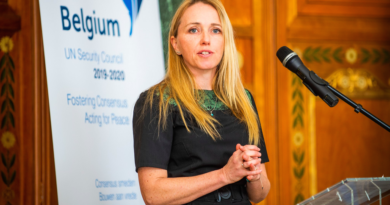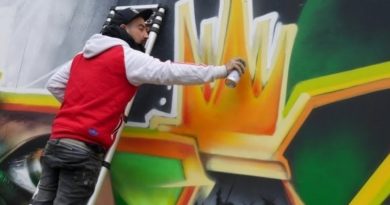International Wildlife Day: 10 birds you often see and hear in Brussels
You usually see them fluttering, perching, or hopping about in the city. They often hang out in your backyard. And if you pay close enough attention, you will hear them constantly singing in the background. But how well do you know the feathered residents of Brussels?
Birds are among the most numerous and most visible of the wildlife population of the Brussels-Capital Region. Close to 200 thousand birds of 238 different species have been observed in the region, according to Natagora, a non-government organization that has been monitoring the avian population of Brussels since 1992.
Europe is home to more than 500 wild bird species. In 2009, the European Union adopted the Birds Directive calling on member states to designate Special Protection Areas (SPAs) for the conservation of wild birds and their habitats.
In Brussels, there are three protected bird areas: the Sonian Forest, the marshes of Jette and Ganshoren, and Uccle’s domaine of protected zones. But wild birds are becoming more and more comfortable with busy city life.
“If you open your eyes, you will see that there is wildlife everywhere in the city. Not just birds, but also mammals, reptiles, and amphibians. Animals are becoming more adaptable to human beings. Human civilizations mean food supply. They need to be adaptable in order to survive,” says Alain Paquet, ornithologist and director of Natagora’s bird monitoring program.
Since they’re here to stay droppings and all, we might as well get to know our city’s winged inhabitants a little better. On International Wildlife Day, we present the most active birds of Brussels.
Blackbirds (Merle noir/Merel)
“Blackbird singing in the dead of night,” so goes the Beatles hit song. Perhaps no other bird has been the subject of many cultural and literal references, and with good reason. This bird species is known to produce some of the most beautiful bird songs.
Compared to other birds with black plumage, the blackbird has a yellow beak and yellow rings around its eyes. The females are darker brown in color. Blackbirds are at home both in urban and remote settings.
Crows (Corneille/Kraai)
Compared to blackbirds, crows are larger and black all over with occasional greyish feathers. Their beak and legs are also stouter.
If they look shrewd to you, that’s because apparently they are. Studies have shown that these excellent scavengers are among the brightest animals in the world. They have exhibited an ability to use tools to acquire food.
“They are also very keen observers. Crows watch their fellow birds to get a sense of whether they are well fed or not. And then they will follow these well-fed birds to see where they get their food supply,” says Alain Paquet.
Chickadees (Mésange/Mees)
These cute, little, chubby birds are the ones that usually hog the bird feeders installed in the backyard. And they certainly can acrobat their way around a bird feeder better than other types of birds.
In Brussels, chickadees or tits are either blue or dark grey with a yellow belly. These lively birds are quite comfortable loafing around in populated areas and public places.
Robins (Rouge-gorge/Roodborstje)
With their lovely orange breasts, robins are easy to spot and a sight to behold. And with their sweet voice, they are also a delight to the ear.
Robins are typically heard singing in the evening or at dawn especially during winter when they declare their territories through sounds.
What is most interesting about robins is their ability to nest practically anywhere that offers shelter, including unusual places like mail boxes, flower pots, watering cans, and unused machines.
European magpies (Pie Bavarde/Ekster)
Another frequent garden caller, magpies can easily be identified by their white belly and long tail. They also have a wingspan of up to 60 centimeters.
But don’t be fooled by their graceful appearance. These predators are known to savage smaller types of birds like chickadees, robins, and blackbirds, and feed on their chicks and eggs.
Like the crows, magpies are also known to be extremely intelligent. They are the only bird species in the list of animals that have passed the mirror self-recognition test.
Sparrows (Moineau/Sperwer)
These small birds with brown and grey feathers are among the earliest and most audible tweeters in your neighborhood.
Two types of sparrows can be found in Brussels. The tree sparrow lives mostly in wooded areas while the house sparrow is a city dweller that nests on the roof of buildings and houses.
According to Natagora, 95 percent of sparrows in Brussels have disappeared in recent years. One of the reasons is the renovation and modernization of architecture in the city.
“New, modern houses and buildings in Brussels no longer have crevices and hollow areas where sparrows can build their nests. These are the only dwelling places for house sparrows. They don’t nest in parks or forests,“ explains Alain.
Other causes are air pollution and the removal of shrubs in the city. Sparrows feed their young with aeroplankton insects which are disappearing slowly because of dirty air while shrubs are vital to the social lives of sparrows.
Several initiatives have been undertaken to revive the sparrow population of Brussels. In Saint-Gilles, a citizens’ collective is actively campaigning for the protection of these native birds of Belgium.
Black swifts (Martinet Noir/Gierzwaluw)
You will rarely see them on land. But if you look up, you just might catch sight of them. Black swifts spend most of their lives in flight.
These birds have sooty grey feathers and long, sickle-shaped wings. They nest in high-altitude places and usually live on top of buildings in Brussels.
Dunnocks (Accenteur Mouchet/Heggenmus)
Probably the smallest of the bird species in Brussels, dunnocks resemble house sparrows but their brown feathers are streaked. They also have a more pointed beak.
Dunnocks are the ordinary-looking birds often seen foraging on the ground for food. But don’t underestimate them. They may look somewhat dull and meek in appearance, but these birds can be fierce when it comes to protecting their territory.
Pigeons (Pigeon/Duif)
Oh the bird that most people love…. to hate. Much as we might want to exclude them, pigeons are undeniably the most pervasive birds in Brussels, and almost everywhere else.
Pigeons are as opportunistic and adaptable as crows but not as smart. They can survive almost anywhere because they are not so picky about what they eat. Even garbage is a potential banquet for them.
There are three kinds of pigeons in Brussels. There’s the wooden pigeon which normally nests on tree branches, the stock dove which lives in tree holes, and the rock pigeons which are scattered all over the city and usually present in busy places like the Grand Place and Place Flagey.
Parakeets (Perruche/Parkiet)
These members of the parrot family are among the most charismatic and colorful birds you will encounter in the parks of Brussels. But they are also quite controversial.
Parakeets are currently the most numerous exotic bird species in Europe. These tropical birds may have multiplied in European cities from escaped or released pet parakeets.
Their growing population has caused alarm in recent years. Parakeets are perceived to be a potential threat to indigenous birds and to local biodiversity.
“It’s exactly the safe reflex some people have towards the issue of human migration. There’s a sort of bio-xenophobia because they fear that exotic birds might steal the habitat and food supply of native birds,” says Alain.
But how much of a menace are these parakeets? “In Brussels and all of Belgium, so far we haven’t seen any ecological impact brought on by exotic birds,” says Alain. “These fears are not justified scientifically.”
How to make your home more bird-friendly
To support the bird population of Brussels, Alain recommends placing potted plants in your apartment terrace to attract insects which birds count on for food. If you have a garden, leave about 20 percent of the grass uncut and grow nectar-producing flowers to encourage insect population. Leave some shrubs to provide shelter for birds.
To feed them, Alain recommends sunflower seeds or seed mixtures, corn kernels, peanuts, and bird feeders. Avoid serving them breadcrumbs and other kitchen scraps which can do birds more harm than good. Alain reminds us to feed animals not for our amusement but for their survival.
If you want to participate in the bird monitoring initiative in Brussels, you can log onto to Natagora’s wildlife observation website and share your sightings.



